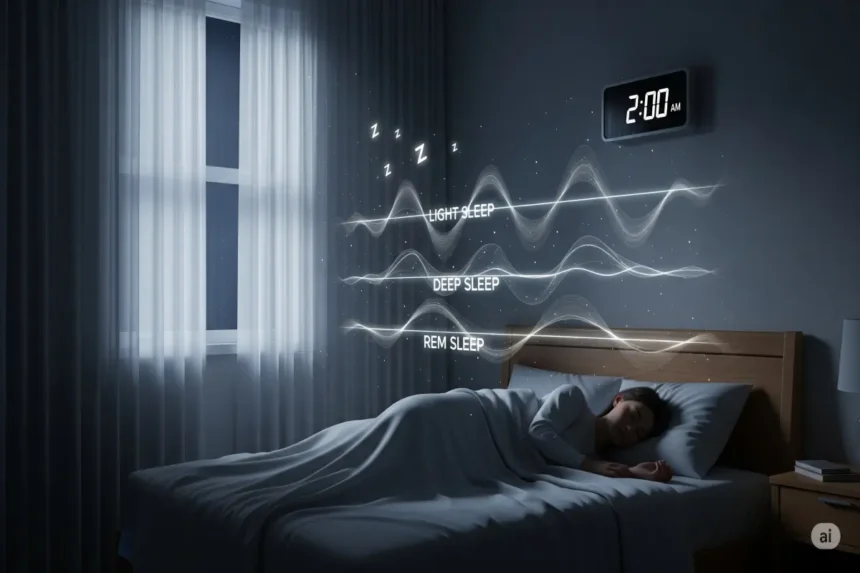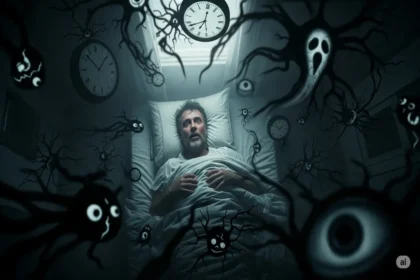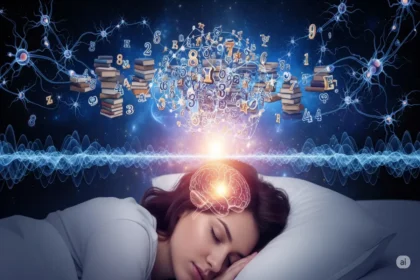As the day’s hustle fades and we finally surrender to the allure of our beds, we embark on a nightly odyssey into the mysterious realm of sleep. It might seem like a simple period of unconsciousness, a mere pause in our waking lives, but beneath the surface, our brains are orchestrating an intricate symphony of activity, cycling through distinct phases that are vital for our physical and mental restoration. This complex journey, moving from REM to NREM sleep, is not just about resting; it’s a meticulously choreographed dance that underpins our memory, emotional regulation, and overall well-being. Understanding these stages offers a profound glimpse into the evolutionary brilliance of our biology and the profound importance of a good night’s rest.
For centuries, sleep was largely considered a passive state, a time when the brain simply “shut down.” However, the groundbreaking discovery of Rapid Eye Movement (REM) sleep in the 1950s by researchers Eugene Aserinsky and Nathaniel Kleitman revolutionized our understanding. They observed that during certain periods of sleep, subjects’ eyes darted rapidly, even though they were deeply asleep. This discovery, coupled with subsequent research, unveiled that sleep is an active, dynamic process, far more complex and purposeful than previously imagined. Our nightly slumber is a meticulously structured cycle, weaving through different stages, each with its own unique brainwave patterns, physiological characteristics, and crucial functions.
The Sleep Cycle Unveiled: A Nightly Progression
A typical night’s sleep for an adult is composed of multiple cycles, each lasting approximately 90 to 110 minutes. Within each cycle, we transition through two primary types of sleep: Non-Rapid Eye Movement (NREM) sleep, which is further divided into three distinct stages (N1, N2, N3), and Rapid Eye Movement (REM) sleep. We typically begin our sleep journey in NREM, progressing through its stages before entering the first bout of REM sleep. As the night progresses, the proportion of deep NREM sleep decreases, while REM sleep periods become longer and more frequent, particularly in the latter half of the night.
Think of it like a descent into a deep, restorative well, followed by a lighter, more active period, and then a gradual re-ascent, repeated several times until morning. Each stage plays a unique and indispensable role in ensuring we wake up refreshed, resilient, and ready to face the world.
NREM Sleep: The Deeper Dive into Restoration
NREM sleep, often referred to as “quiet sleep,” accounts for about 75-80% of our total sleep time. It’s characterized by a slowing of brain activity, heart rate, and breathing, and it’s during these stages that much of our physical restoration and certain types of memory consolidation occur.
N1 (NREM Stage 1): The Drowsy Transition
This is the lightest stage of sleep, a fleeting transition between wakefulness and true sleep, lasting only a few minutes. As we drift into N1, our brain activity begins to slow, marked by the appearance of theta waves. Our muscles relax, our heart rate and breathing slow down slightly, and our eyes move slowly under our eyelids.
It’s during this stage that you might experience sudden muscle contractions, known as hypnic jerks or sleep starts, often accompanied by a sensation of falling. These are completely normal and are thought to be residual muscle activity as the brain transitions into a more relaxed state. Waking someone during N1 is relatively easy; they might even deny they were asleep, describing it more as a state of deep relaxation or daydreaming. While not as restorative as the deeper stages, N1 is crucial for initiating the sleep process, gently easing our bodies and minds into the nightly journey.
N2 (NREM Stage 2): Settling In
As we move past the initial drift, we enter N2, which typically constitutes about 50% of our total sleep time, making it the longest stage. Here, our brain activity continues to slow, characterized by two distinctive brainwave patterns: sleep spindles and K-complexes. Sleep spindles are bursts of rapid, rhythmic brainwave activity, while K-complexes are sudden, high-amplitude waves.
Scientists believe that sleep spindles play a vital role in memory consolidation, particularly in transferring memories from the hippocampus (a temporary storage area) to the prefrontal cortex (a more permanent storage area). They act like internal “refreshers,” solidifying new information and skills learned during the day. K-complexes, on the other hand, are thought to protect us from waking up in response to external stimuli, acting as a kind of gatekeeper that allows us to stay asleep despite minor disturbances. If you’ve ever slept through a loud noise but woken up to a soft alarm, your K-complexes might have been hard at work. During N2, our body temperature drops, and our heart rate and breathing become even more regular. While some dreaming can occur in N2, it’s generally less vivid and more fragmented than REM dreams, often described as fleeting thoughts or images.
N3 (NREM Stage 3): Deep Sleep’s Embrace (Slow-Wave Sleep)
This is the deepest and most restorative stage of NREM sleep, often referred to as “slow-wave sleep” due to the prominence of slow, high-amplitude delta waves in brain activity. During N3, our physiological activity reaches its lowest point: heart rate, breathing, and brain activity are significantly reduced, and our muscles are completely relaxed. It is incredibly difficult to wake someone from N3 sleep, and if roused, they often feel disoriented and groggy.
N3 sleep is critical for physical recovery and growth. It’s during this stage that the body repairs and regrows tissues, builds bone and muscle, and strengthens the immune system. Crucially, it’s also when the pituitary gland releases growth hormone, essential for development in children and tissue repair in adults. From a cognitive perspective, N3 is vital for the consolidation of declarative memories – facts, events, and general knowledge. Imagine a student who has spent the day absorbing complex historical dates and figures; N3 sleep is where that information is firmly etched into their long-term memory. This is also the stage where sleepwalking, sleep talking, and night terrors are most likely to occur, as the body is deeply relaxed but the brain can still initiate some motor activity.
REM Sleep: The Paradoxical Playground
After cycling through the NREM stages, we finally arrive at REM sleep, a truly fascinating and paradoxical state. Although it’s a deep stage of sleep, the brain activity during REM closely resembles that of wakefulness. This is why it’s also known as “paradoxical sleep.” It accounts for about 20-25% of our total sleep time and becomes progressively longer as the night wears on.
The hallmarks of REM sleep are unmistakable: rapid, jerky eye movements (hence the name), increased brain activity, a temporary paralysis of most voluntary muscles (known as atonia, which prevents us from acting out our dreams), and vivid, often bizarre, dreams. Our heart rate and breathing become more irregular and shallow, and blood flow to the brain increases.
The purpose of REM sleep is multifaceted. It’s strongly linked to emotional processing and regulation. During REM, the amygdala (our emotional center) is highly active, while norepinephrine, a stress-related neurochemical, is largely absent. This unique neurochemical environment allows the brain to re-process emotionally charged memories from the day in a “safe” space, effectively dampening their emotional intensity. Dr. Matthew Walker, a leading sleep neuroscientist, often refers to REM sleep as “overnight therapy,” highlighting its role in alleviating the sting of difficult experiences and fostering emotional resilience.
REM sleep is also crucial for procedural memory consolidation – the learning of skills and habits. If you’re learning to play a musical instrument or master a new sport, your brain is actively rehearsing and refining those motor sequences during REM sleep. Furthermore, this stage is a hotbed of creativity and problem-solving. The brain’s ability to make novel, seemingly illogical connections during REM can lead to “aha!” moments and innovative insights upon waking. Many artists and scientists have reported breakthroughs that came to them in dreams, a testament to the brain’s uninhibited associative thinking during this unique state.
The dreams experienced during REM sleep are typically more vivid, narrative-driven, and emotionally intense than those in NREM. While NREM dreams tend to be more thought-like or fragmented, REM dreams are the full-blown cinematic experiences we often remember upon waking.
The Dance of the Stages: A Nightly Symphony
Throughout the night, our sleep cycles repeat, typically four to six times. In the early part of the night, NREM stages, particularly N3 (deep sleep), dominate. This is when the most profound physical restoration and declarative memory consolidation occur. As the night progresses, the duration of REM sleep periods gradually increases, becoming longest in the hours just before waking. This shift ensures that by morning, we’ve had ample time for emotional processing, creative synthesis, and procedural memory refinement.
This dynamic interplay between NREM and REM sleep is a finely tuned biological rhythm, essential for maintaining both our physical and mental health. Disruptions to this cycle, whether due to lifestyle choices, sleep disorders, or external factors, can have significant repercussions on our cognitive function, mood, immune system, and overall quality of life.
The Purposeful Journey: Beyond Mere Rest
The journey from REM to NREM is far more than a passive state of rest; it’s an active, purposeful endeavor orchestrated by our remarkable brains. Each stage, with its unique characteristics and functions, contributes to a holistic process of restoration, learning, and emotional regulation. Deep NREM sleep rejuvenates our bodies and solidifies our factual knowledge, while REM sleep acts as our nightly therapist, creative muse, and skill trainer.
The scientific exploration of sleep continues to unveil new layers of complexity and importance, reinforcing the ancient wisdom that sleep is not a luxury but a fundamental necessity. It is during these nightly narratives that our brains work tirelessly, weaving together the threads of our experiences, preparing us for the challenges and opportunities of the coming day, and ultimately, shaping the very essence of who we are. So, as you prepare for your next journey into slumber, remember the intricate dance unfolding within you – a testament to the profound and enduring evolutionary purpose of our nightly descent into the world of dreams.
Disclaimer: The information provided in this article is for general informational purposes only and does not constitute medical advice. It is not a substitute for professional medical advice, diagnosis, or treatment. Always seek the advice of your physician or other qualified health provider with any questions you may have regarding a medical condition. Never disregard professional medical advice or delay in seeking it because of something you have read on this website.














